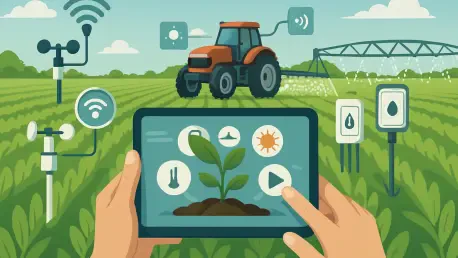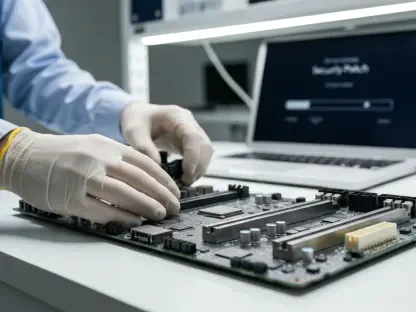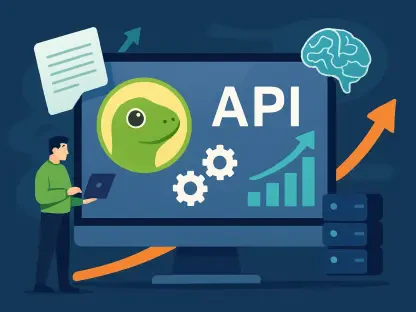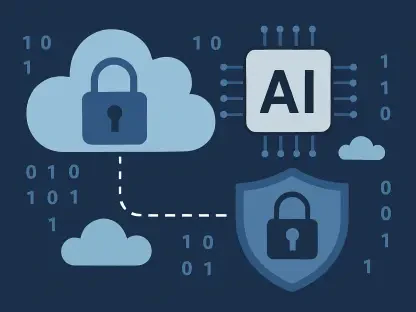In a world where global population growth, climate variability, and food insecurity pose mounting challenges, agriculture stands on the brink of a groundbreaking transformation with the emergence of Farming 5.0, a new era powered by Artificial Intelligence (AI), the Internet of Things (IoT), and Machine Learning (ML). This era transcends the automation of Farming 4.0 to deliver fully autonomous, adaptive, and intelligent farming systems that minimize human intervention while maximizing efficiency and sustainability. These technologies are not mere tools but the foundation of a hyper-connected agricultural ecosystem. From predicting crop outcomes to monitoring livestock in real time, Farming 5.0 is reshaping how food is produced to meet the demands of a rapidly changing planet.
The promise of this technological leap is evident in its ability to tackle pressing issues with precision and foresight. Farmers, whether managing small family plots or vast agribusinesses, now have access to data-driven insights that optimize every facet of their operations. Platforms like Farmonaut are playing a pivotal role by democratizing satellite-based analytics and AI tools, ensuring that even resource-limited growers can harness these advancements. As adoption rates climb, with projections showing over half of global farms integrating such systems in the near term, the agricultural landscape is shifting toward a future where efficiency, environmental care, and food security converge in unprecedented ways.
The Technological Backbone of Modern Agriculture
Synergy of AI, IoT, and ML
The core of Farming 5.0 lies in the seamless integration of AI, IoT, and ML, each contributing distinct yet interconnected capabilities to revolutionize agricultural practices. AI serves as the analytical powerhouse, sifting through enormous datasets to provide predictive guidance on crop selection, pest control, and resource allocation. It can, for instance, forecast yield potential based on historical trends and current weather patterns, enabling farmers to make informed decisions well in advance. This data-driven approach reduces uncertainty and enhances planning, setting a new standard for farm management. Meanwhile, the role of AI extends beyond prediction to optimization, ensuring that every action taken on the farm is backed by actionable intelligence derived from complex algorithms.
Complementing AI, IoT acts as the connective tissue of the farm, linking an array of sensors and devices to monitor conditions in real time. Soil moisture levels, weather shifts, and even livestock health can be tracked continuously through IoT networks, delivering instant updates to farmers via mobile or web platforms. This connectivity allows for immediate responses to changing conditions, such as activating irrigation during a dry spell or alerting to a potential disease outbreak among animals. The real-time nature of IoT transforms farms into responsive ecosystems where delays and guesswork are minimized, paving the way for a level of operational precision that was once unimaginable in traditional agriculture.
Machine Learning rounds out this technological triad by enabling systems to adapt and improve over time. Unlike static models, ML algorithms learn from each cycle of data, refining their accuracy in predicting outcomes or identifying inefficiencies. For example, an ML system might initially struggle to detect early signs of crop stress but, through iterative learning, become adept at spotting subtle indicators before they escalate. This adaptability ensures that farming solutions remain relevant amid fluctuating environmental or market conditions, offering a dynamic edge to growers. Together, these technologies form a robust framework that drives autonomy, projecting a significant shift in how global agriculture operates in the coming years.
Building Autonomous Farm Ecosystems
The combined power of AI, IoT, and ML fosters the creation of autonomous farm ecosystems, drastically reducing the need for manual oversight while enhancing productivity. Consider a scenario where AI analyzes long-term weather forecasts alongside soil data to recommend the optimal planting schedule, while IoT sensors embedded in the field trigger irrigation only when moisture levels dip below a critical threshold. This level of automation ensures resources are used efficiently, cutting down on waste and labor costs. Such systems are not just reactive but proactive, anticipating needs and adjusting operations before issues arise, marking a departure from the human-guided approaches of previous agricultural models.
Beyond individual tasks, autonomy in Farming 5.0 extends to entire farm operations, creating a self-sustaining cycle of monitoring, analysis, and action. Automated machinery, guided by real-time data and AI insights, can execute complex tasks like planting or harvesting with pinpoint accuracy, optimizing routes to save fuel and time. Livestock management also benefits, with wearable IoT devices detecting health anomalies and prompting early interventions without constant human supervision. This shift toward cognitive farming, where systems think and act independently, is reshaping the industry, with adoption trends indicating a majority of farms worldwide embracing these innovations to stay competitive in a demanding market.
Precision Agriculture: Optimizing Every Resource
Targeted Resource Management
Precision agriculture emerges as a defining feature of Farming 5.0, leveraging data to ensure resources are applied only where and when they are needed, thus transforming efficiency standards. Smart irrigation systems exemplify this approach, using IoT sensors to measure soil moisture in real time while AI integrates weather predictions to determine exact watering requirements. This means water is delivered only under specific conditions, preventing over- or under-irrigation that plagues traditional methods. The result is a significant reduction in water waste, a critical advantage in regions grappling with drought, alongside healthier crops that receive just the right amount of hydration for optimal growth.
Fertilizers and pesticides also benefit from precision tactics, as satellite imagery and ML models identify specific areas of a field requiring treatment. Instead of blanket applications that often lead to overuse, farmers can target only affected zones, cutting input costs and minimizing environmental runoff that harms soil and waterways. Platforms like Farmonaut amplify this capability by offering scalable satellite monitoring, enabling even large operations to manage vast tracts of land with pinpoint accuracy. Reports suggest that such precision techniques can boost yields by 15-30%, demonstrating how data-driven resource allocation not only saves money but also drives higher output in an era of increasing food demand.
Balancing Profitability with Conservation
The economic benefits of precision agriculture are matched by its environmental impact, creating a harmonious balance between profitability and conservation. By reducing the overuse of water, chemicals, and fuel through targeted applications and optimized machinery routes, farmers see lower operational expenses without sacrificing productivity. This cost-effectiveness is vital for smallholder farmers operating on tight margins, allowing them to invest savings into other areas of their business. At the same time, the decreased reliance on broad-scale resource use means less strain on local ecosystems, preserving natural resources for long-term agricultural viability.
Moreover, precision agriculture supports compliance with increasingly stringent environmental regulations, as reduced emissions and pollution align with global sustainability targets. Automated systems, guided by real-time data, ensure that every decision—from planting density to pesticide timing—considers both economic and ecological outcomes. This dual focus positions precision agriculture as more than a fleeting trend; it is a fundamental shift in how farming can sustain both livelihoods and the planet. As adoption spreads, the approach is proving essential for addressing resource scarcity while meeting the nutritional needs of a growing population, redefining success in modern agriculture.
Sustainability and Resilience in Focus
Reducing Environmental Footprints
Sustainability takes center stage in Farming 5.0, with technologies designed to minimize agriculture’s environmental footprint while maintaining high productivity levels. Targeted application of inputs like fertilizers and pesticides, driven by AI and IoT data, prevents excess usage that often leads to soil degradation and water pollution. For instance, AI recommendations might suggest a reduced fertilizer dose for a specific plot based on current nutrient levels, avoiding overapplication that harms the surrounding environment. Such precision ensures that farms contribute less to ecological damage, preserving vital resources like clean water and fertile land for future use.
Carbon footprint tracking tools further enhance sustainability efforts by allowing farmers to monitor emissions from machinery, livestock, or other operations. Platforms like Farmonaut provide accessible solutions for measuring and mitigating these impacts, encouraging the adoption of climate-smart practices such as crop rotation or reduced tillage. These methods not only lower greenhouse gas outputs but also improve soil health, creating a cycle of environmental benefits. By integrating sustainability into daily operations, Farming 5.0 aligns agricultural growth with global efforts to combat climate change, demonstrating that food production and planetary care can coexist effectively.
Strengthening Climate Resilience
Building resilience against climate variability is another critical aspect of Farming 5.0, as predictive analytics empower farmers to anticipate and adapt to adverse conditions. AI-driven models analyze historical and real-time data to forecast events like droughts, floods, or heatwaves, enabling proactive measures such as adjusting planting schedules or reinforcing crop protection. This foresight helps safeguard yields against unpredictable weather patterns that increasingly threaten global food supplies. Farmers equipped with these tools can maintain stability in production, even under environmental stress, ensuring a consistent output regardless of external challenges.
Additionally, resilience extends to long-term farm viability through practices that sustain natural ecosystems alongside agricultural needs. Technology facilitates the integration of biodiversity-friendly methods, such as intercropping or maintaining buffer zones, which protect against soil erosion and pest surges naturally. These strategies, supported by data insights, reduce dependency on chemical interventions while bolstering farm durability against climate shifts. As sustainability and resilience intertwine, Farming 5.0 offers a blueprint for agriculture that not only survives but thrives amid global uncertainties, securing food systems for generations to come.
Overcoming Barriers to Adoption
Navigating Financial and Technical Hurdles
Despite the transformative potential of Farming 5.0, significant barriers to adoption persist, particularly around financial and technical constraints that can hinder widespread implementation. The upfront costs of IoT devices, automated machinery, and other advanced systems often present a steep barrier, especially for smallholder farmers or those in developing regions with limited access to capital. While subscription-based platforms help lower ongoing expenses, the initial investment remains daunting for many, risking a divide where only well-funded operations can fully embrace these innovations. Addressing this requires innovative financing models, such as government subsidies or satellite-verified crop loans, to ease the economic burden and expand access.
Technical challenges compound the financial ones, as digital literacy gaps prevent many farmers from effectively utilizing data-driven tools. Interpreting complex analytics or navigating mobile apps can be overwhelming without proper training, particularly in rural areas where educational resources are scarce. Additionally, unreliable internet and power infrastructure in these regions disrupts the connectivity essential for real-time IoT monitoring and cloud-based systems. Tackling these issues demands targeted training programs and investments in rural infrastructure to ensure that technological advancements are not just available but usable, bridging the gap between innovation and practical application for all farmers.
Securing Data and Building Trust
As farms become increasingly connected under Farming 5.0, concerns over data privacy and cybersecurity emerge as critical obstacles that must be addressed to maintain trust and adoption. The vast amounts of sensitive information generated—ranging from crop health details to financial records—are often stored on cloud platforms, making them vulnerable to breaches or misuse. Farmers, especially those new to digital systems, may hesitate to adopt technologies if they fear their data could be compromised or exploited. This apprehension underscores the need for robust security measures, including encryption and secure access protocols, to protect agricultural data from unauthorized access.
Beyond technical safeguards, building trust requires transparency and collaboration between technology providers, policymakers, and farming communities. Clear policies on data ownership and usage must be established to assure farmers that their information remains under their control. Partnerships can also play a vital role, with governments and private entities working together to offer secure, user-friendly platforms while educating users on safe digital practices. Overcoming these privacy and security challenges is essential to ensure that the benefits of Farming 5.0—higher productivity, sustainability, and resilience—are realized without sacrificing the confidence of those at the heart of agriculture. Moving forward, collective efforts will determine how effectively these barriers are dismantled, paving the way for an inclusive technological revolution.
Shaping a Sustainable Agricultural Future
Reflecting on a Technological Milestone
Looking back, the rise of Farming 5.0 marked a pivotal moment in agricultural history, where AI, IoT, and ML converged to create intelligent, autonomous systems that redefined food production. These technologies empowered farmers to achieve unprecedented levels of precision, slashing resource waste while boosting yields through data-driven decisions. Sustainability became more than an ideal; it was embedded into everyday practices with tools that curbed pollution and tracked carbon emissions, ensuring farms played a role in combating climate change. Platforms like Farmonaut democratized access, bringing cutting-edge insights to diverse farming communities and proving that innovation could bridge economic divides.
Charting the Path Ahead
As the journey continues, the focus must shift to actionable strategies that address lingering challenges and amplify the reach of Farming 5.0. Governments and tech providers should prioritize affordable access through subsidies and scalable solutions, ensuring smallholder farmers aren’t sidelined by cost barriers. Investments in rural infrastructure, like reliable internet and power, are non-negotiable to sustain connected systems, while comprehensive training programs can close digital literacy gaps, empowering growers to leverage technology confidently. Strengthening data security frameworks will also be crucial to protect farm information and maintain trust in digital tools. By fostering collaboration across sectors, the agricultural community can build on past achievements, driving toward a future where technology ensures food security and environmental harmony for all.









